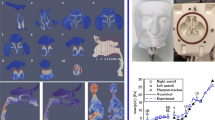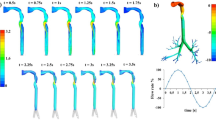Abstract
Computer simulations of airflow and particle-transport phenomena within the human respiratory system have important applications to aerosol therapy (e.g., the targeted delivery of inhaled drugs) and inhalation toxicology (e.g., the risk assessment of air pollutants). A detailed description of airway morphology is necessary for these simulations to accurately reflect conditions in vivo. Therefore, a three-dimensional (3D) physiologically realistic computer model of the human upper-respiratory tract (URT) has been developed. The URT morphological model consists of the extrathoracic (ET) region (nasal, oral, pharyngeal, and laryngeal passages) and upper airways (trachea and main bronchi) of the lung. The computer representation evolved from a silicone rubber impression of a medical school teaching model of the human head and throat. A mold of this ET system was sliced into 2-mm serial sections, scanned, and digitized. Numerical grids, for use in future computational fluid dynamics (CFD) simulations, were generated for each slice using commercially available software (CFX-F3D), AEA Technology, Harwell, UK. The meshed sections were subsequently aligned and connected to be consistent with the anatomical model. Finally, a 3D curvilinear grid and a multiblock method were employed to generate the complete computational mesh defined by the cross-sections. The computer reconstruction of the trachea and main bronchi was based on data from the literature (cited herein). The final unified 3D computer model may have significant applications to aerosol medicine and inhalation toxicology, and serve as a cornerstone for computer simulations of air flow and particle-transport processes in the human respiratory system.
Similar content being viewed by others
References
Martonen, T. B. and Lowe, J. (1983) Assessment of aerosol deposition patterns in human respiratory tract casts, in Aerosols in the Mining and Industrial Work Environments: Fundamentals and Status Marple, V. A., and Liu, B. Y. H. (eds.), Ann Arbor Science Publishers, Ann Arbor, MI, pp. 151–164.
Martonen, T. B. (1992) Deposition patterns of cigarette smoke in human airways. Am. Indus. Hyg. Assoc. J. 53, 6–18.
Martonen, T. B. and Musante, C. J. (2000) Importance of cloud motion on cigartette smoke deposition in lung airways. Inhal. Toxicol. 12(Suppl. 4): 261–280.
Yu, G., Zhang, Z., and Lessmann, R. (1996) Numerical study of fluid flow and mass transfer in human bifurcation airways. Aerosol Sci. Technol. 25, 338–352.
AEA Technology (1995) CFX 4.1 Flow Solver User Guide. AEA Technology, Harewell, UK
Heyder, J. and Rudolf, G. (1977) Deposition of aerosol particles in the human nose, in Inhaled Particles IV (Walton, W. H. ed.), Pergamon Press, Oxford, pp. 107–126.
Martonen, T. B. and Zhang, Z. (1992) Comments on recent data for particle deposition in human nasal passages. J. Aerosol Sci. 23, 667–674.
Hahn, I., Scherer, P. W., and Mozell, M. M. (1993) Velocity profiles measured for airflow through a large scale model of the human nasal cavity. J. Appl. Physiol. 75, 2273–2287.
Cheng, K., Cheng, Y., Yeh, H., and Swift, D. L. (1995) Deposition of ultrafine aerosols in the head airways during natural breathing and during simulated breath holding using replicated human upper airway casts. Aerosol Sci. Technol. 23, 465–474.
Asgharian, B. and Anjivel, S. (1994) Inertial and gravitational deposition of particles in a square cross section bifurcating airway. Aerosol Sci. Technol. 20, 177–193.
Hofmann, W., Balashazy, I., and Koblinger, L. (1995) Effect of gravity on particle deposition patterns in bronchial airway bifurcations. J. Aerosol Sci. 26, 177–193.
Zhang, L., Asgharian, B., and Anjivel, S. (1997) Inertial deposition of particles in the human upper airway bifurcations. Aerosol Sci. Technol. 26, 97–110.
Martonen, T. B., Musante, C. J., Segal, R. A., Schroeter, J. D., Hwang, D., Dolovich, M., et al. (2000) Lung models: strengths and limitations. Respir. Care 45, 712–736.
Musante, C. J. and Martonen, T. B. (2001) Computational fluid dynamics in human lungs I: effects of natural airway features, in Medical Applications of Computer Modelling: the Respiratory System Martonen, T. B. (ed.), WIT Press, Southampton, UK, pp. 131–145.
Keyhani, K., Scherer, P. W., and Mozell, M. M. (1995) Numerical simulation of airflow in the human nasal cavity. J. Biomech. Eng. 117, 429–441.
Subramaniam, R. P., Richardson, R. B., Morgan, K. T., Kimbell, J. S., and Guilmette, R. A. (1998) Computational fluid dynamics simulations of inspiratory airflow in the human nose and nasopharynx. Inhal. Toxicol. 10, 91–120.
Yu, G., Zhang, Z., and Lessmann, R. (1998) Fluid flow and particle diffusion in the human upper respiratory system. Aerosol Sci. Technol. 28, 146–158.
Schroeter, J. D., Musante, C. J., Hwang, D., Burton, R., Guilmette, R., and Martonen, T. B. (2001) Hygroscopic growth and deposition of inhaled secondary cigarette smoke in human nasal pathways. Aerosol Sci. Technol. 34, 137–143.
Martonen, T. B. (1993) Mathematical model for the selective deposition of inhaled pharmaceuticals. J. Pharmaceut. Sci. 82, 1191–1199.
Mygind, N. (1985) Upper airway: structure, function, and therapy, in Aerosols in Medicine: Principles, Diagnosis, and Therapy Moren, F., Newhouse, M. T., and Dolovich, M. B. (eds.), Elsevier Science Publishing (Biomedical Division), New York, pp. 1–26.
Martonen, T. B., Zhang, Z., and Lessmann, R. C. (1993) Fluid dynamics of the human larynx and upper tracheobronchial airways. Aerosol Sci. Technol. 19, 133–156.
Katz, I. M., Davis, B. M., and Martonen, T. B. (1999) A numerical study of particle motion within the human larynx and trachea. J. Aerosol Sci. 30, 173–183.
Katz, I. M. (2001) Computer modeling of fluid dynamics and particle motion in the larynx and trachea, in Medical Applications of Computer Modelling: the Respiratory System, Martonen, T. B., (ed.), WIT Press, Southampton, UK, pp. 47–63.
Martonen, T. B., Yang, Y., and Xue, Z. Q. (1994) Influences of cartilaginous rings on tracheobronchial fluid dynamics. Inhal. Toxicol. 6, 185–203.
Martonen, T. B., Zhang, Z., and Yang, Y. (1997) Particle diffusion from developing flows in rough-walled tubes. Aerosol Sci. Technol. 26, 1–11.
Author information
Authors and Affiliations
Corresponding author
Rights and permissions
About this article
Cite this article
Martonen, T.B., Zhang, Z., Yu, G. et al. Three-dimensional computer modeling of the human upper respiratory tract. Cell Biochem Biophys 35, 255–261 (2001). https://doi.org/10.1385/CBB:35:3:255
Issue Date:
DOI: https://doi.org/10.1385/CBB:35:3:255




